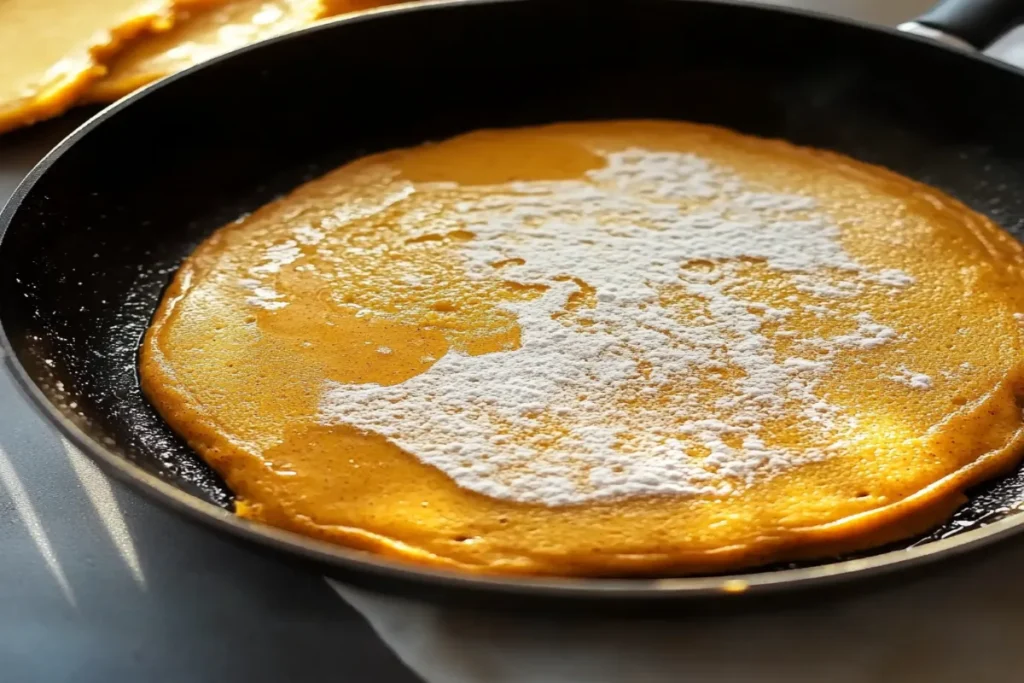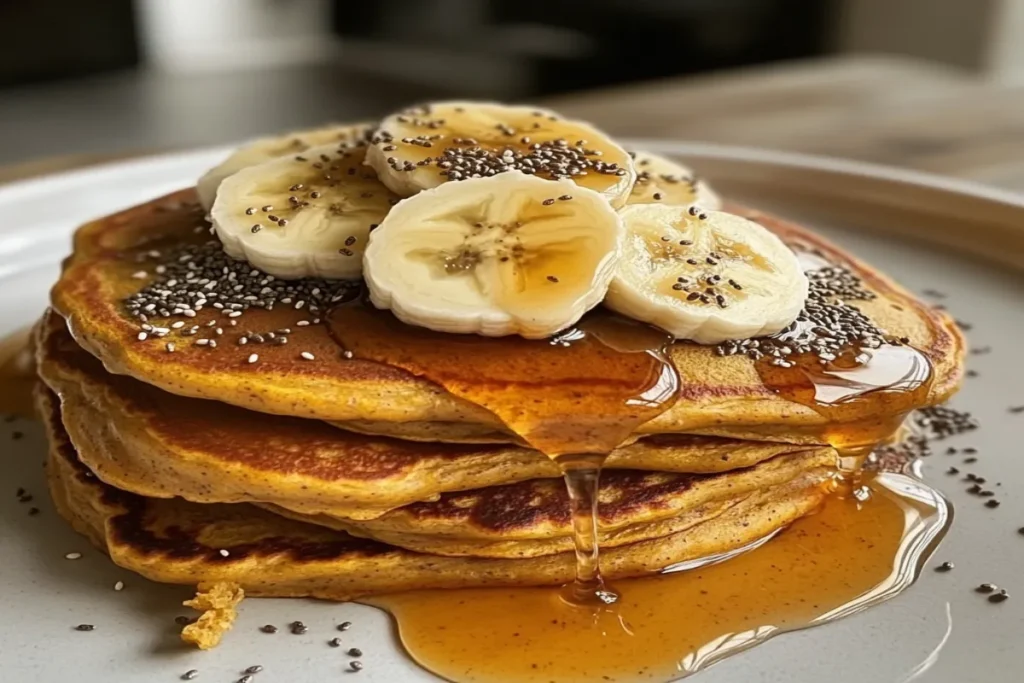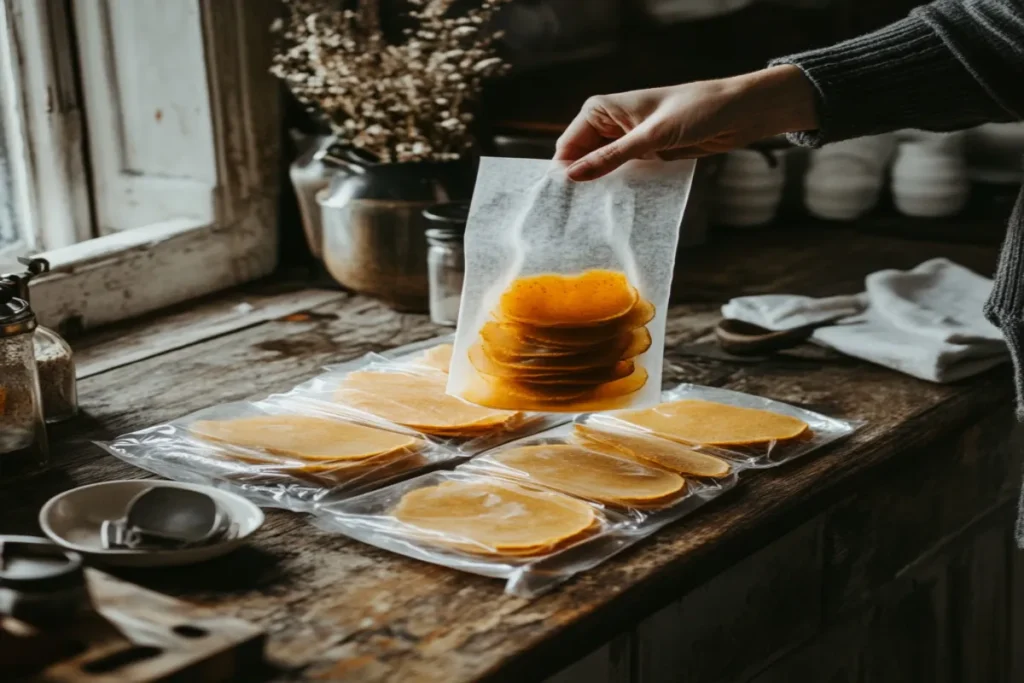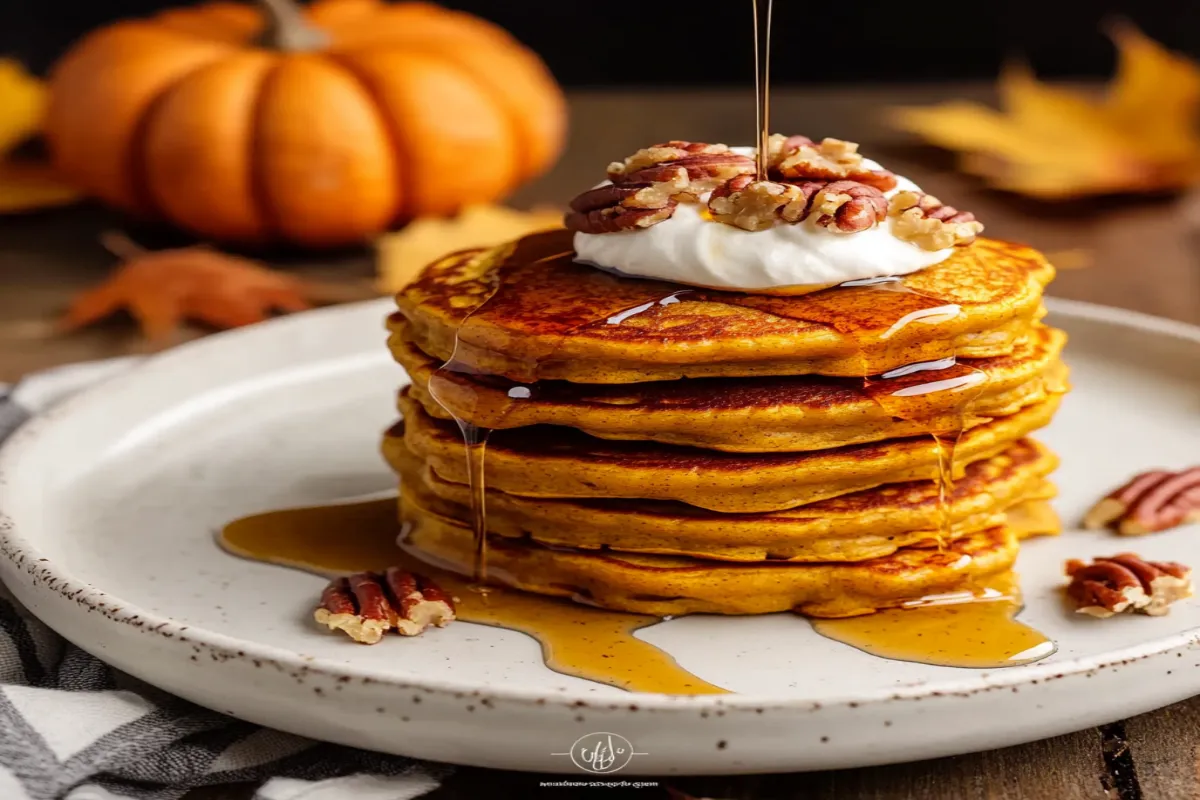Nothing screams cozy like the scent of pumpkin spice on a crisp fall morning — and if you’re living that gluten-free life, these gluten-free pumpkin pancakes might just become your new autumn obsession. They’re fluffy, warmly spiced, and incredibly easy to make with clean, wholesome ingredients. Whether you’re sensitive to gluten or just looking to switch up your breakfast game, this recipe is about to become your seasonal favorite.
We’ll walk you through exactly how to make them, which gluten-free flours work best, and what swaps you can use to keep them dairy-free or low-sugar. You’ll also get pro tips on making them ahead, freezing, reheating, and the best toppings to drizzle, dollop, or pile on top.
Looking for more seasonal breakfasts? Don’t miss our Buttermilk Blueberry Pancakes for a berry twist that’s just as dreamy.
Why Gluten-Free Pumpkin Pancakes Are a Must-Try
The rise of gluten-free fall breakfast recipes
Gluten-free eating isn’t just a trend — it’s a lifestyle for millions of people dealing with celiac disease, gluten intolerance, or those just looking to reduce inflammation. But that doesn’t mean giving up comfort food, especially in fall when pumpkin-spiced everything takes over.
These gluten-free pumpkin pancakes offer a solution: the nostalgic flavor of pumpkin pie in a fluffy, stackable breakfast that’s gentle on the gut and free from gluten. They’re perfect for weekend brunches, holiday mornings, or even meal-prepped weekday breakfasts.
And honestly? Even if you can eat gluten, you’ll still love them. The rich flavor of pumpkin, balanced by cinnamon, nutmeg, and a hint of vanilla, gives these pancakes an unbeatable fall vibe.
Check out What Is the Secret to Good Pancakes — because great technique makes gluten-free pancakes taste just like the classic.
Why pumpkin and spice are perfect for pancakes
Pumpkin isn’t just for pie — it’s a powerhouse ingredient for breakfast, especially in gluten-free cooking. Here’s why it works so well:
- Moisture booster: Pumpkin purée adds moisture to gluten-free batters, which can sometimes turn out dry.
- Nutrient-dense: Loaded with vitamin A, fiber, and antioxidants, pumpkin gives your morning meal a healthy boost.
- Flavor balance: The warm, earthy notes of pumpkin pair beautifully with spices like cinnamon, ginger, and nutmeg — making every bite taste like fall.
Combined with a good gluten-free flour blend, the pumpkin helps create a soft, cake-like texture that holds up beautifully in a skillet. You won’t even miss the gluten.
Want to explore more sweet, spiced pancake options? Try our Banana Chocolate Chip Pancakes for another naturally gluten-free flavor twist.
Ingredients You Need for Gluten-Free Pumpkin Pancakes
Core gluten-free ingredients and fall spices
To make delicious gluten-free pumpkin pancakes, you don’t need anything fancy — just a few pantry staples and some cozy fall spices. Here’s what you’ll want on hand:
| Ingredient | Role in the Recipe |
|---|---|
| Pumpkin purée | Adds moisture, flavor, and richness |
| Gluten-free flour | Forms the pancake base (see options below) |
| Eggs | Binds the batter and helps it rise |
| Milk or dairy-free milk | Thins the batter to the right consistency |
| Baking powder | Makes pancakes light and fluffy |
| Cinnamon & nutmeg | Classic pumpkin spice flavor |
| Maple syrup or sugar | Adds a touch of sweetness |
| Vanilla extract | Boosts overall flavor |
| Salt | Balances sweetness and enhances taste |
📝 Pumpkin Tip: Use 100% pure pumpkin purée, not pumpkin pie filling — the latter is pre-sweetened and spiced, which can throw off your flavor and consistency.
Want to see how add-ins can totally change a pancake recipe? Check out When Should I Add Chocolate Chips to My Pancakes for timing and texture tricks that also work with pumpkin.
Best pumpkin purée and milk alternatives to use
Choosing the right ingredients makes a big difference when cooking gluten-free. Here are the best options we recommend for consistent results:
Pumpkin Purée Options:
- Libby’s 100% Pure Pumpkin: Reliable, smooth texture and widely available
- Homemade pumpkin purée: Works great but be sure to strain it if it’s watery
- Organic canned options: Like Farmer’s Market brand, which is slightly richer
Milk Substitutes:
- Almond milk: Light and nutty, keeps pancakes dairy-free
- Oat milk: Slightly sweet and thick — pairs great with pumpkin
- Coconut milk (carton, not canned): Adds richness and subtle flavor
- Regular milk: Totally fine if you’re not dairy-free
Egg Substitute for Vegan Version:
- 1 tablespoon flaxseed meal + 3 tablespoons water = 1 egg replacement
Let it sit for 5 minutes to gel before adding.
Looking for more mix-ins and creative ways to flavor pancakes? Don’t miss our classic Chocolate Chip Pancakes Recipe for inspiration.
Step-by-Step Recipe for the Perfect Texture
Mixing the batter without overworking gluten-free flour
Working with gluten-free flour means you have to be a little more delicate — but the right technique gets you thick, fluffy pancakes every time. Here’s how to do it right:
Gluten-Free Pumpkin Pancake Batter Recipe
Ingredients:
- 1 cup gluten-free flour (oat flour, 1:1 blend, or almond flour)
- 1 teaspoon baking powder
- ½ teaspoon baking soda (for extra lift)
- ¼ teaspoon salt
- 1 teaspoon ground cinnamon
- ¼ teaspoon nutmeg
- 1 egg (or flax egg for vegan)
- ½ cup pumpkin purée
- ¾ cup milk (dairy or non-dairy)
- 1 tablespoon maple syrup or coconut sugar
- 1 teaspoon vanilla extract
- 1 tablespoon melted coconut oil or butter (optional)
Instructions:
- In one bowl, whisk together your dry ingredients: flour, baking powder, baking soda, salt, and spices.
- In a second bowl, whisk the wet ingredients: pumpkin purée, milk, egg, maple syrup, vanilla, and oil.
- Slowly add the wet mix to the dry mix. Stir gently until just combined. It’s okay if it’s a little lumpy — overmixing will make them dense.
- Let the batter rest for 5–10 minutes. This helps hydrate the flour and improves the texture.
Texture Tip: Gluten-free flours absorb liquid differently. If the batter is too thick, stir in 1 tablespoon of milk at a time. Aim for a thick but pourable consistency.
Cooking tips for golden, fluffy pumpkin pancakes

Now it’s time to bring your batter to life on the skillet. Here’s how to nail the texture and color every single time:
1. Heat the skillet properly:
Preheat a non-stick pan or griddle over medium-low heat. Add a light coating of oil or butter.
2. Pour and shape:
Use ¼ cup of batter per pancake. Smooth gently into a circle — gluten-free batters don’t spread as easily.
3. Cook low and slow:
Pumpkin pancakes cook slower than plain ones due to moisture content. Let them cook 3–4 minutes per side, flipping only once when bubbles appear and the edges firm up.
4. Keep warm (optional):
Place finished pancakes on a baking sheet in a 200°F oven while you cook the rest. This keeps the whole batch warm and fluffy.
5. Serve hot with toppings of your choice!
We’ll dive into topping ideas in Part 8, but for now, maple syrup and chopped pecans are a winning combo.
Want more fall flavor ideas? Discover cozy morning favorites like Banana Chocolate Chip Pancakes — also easy to make gluten-free.
Variations and Customizations
Vegan and dairy-free gluten-free pumpkin pancakes

Making these pancakes completely plant-based is easy with just a couple of smart swaps — and the result is still fluffy, flavorful, and perfect for fall mornings.
Here’s how to make them vegan & dairy-free:
- Replace eggs: Use 1 flax egg (1 tbsp flaxseed meal + 3 tbsp water) for every egg. Let it sit for 5–10 minutes until it thickens before adding it to your batter.
- Swap milk: Use unsweetened almond milk, oat milk, or coconut milk instead of dairy milk.
- Ditch butter: Use melted coconut oil, olive oil, or vegan butter for richness.
Bonus Tips:
- Add 1 tablespoon of apple cider vinegar to your milk substitute before mixing it in — it helps boost fluffiness just like buttermilk.
- Use a little extra baking powder (½ tsp more) to counteract the missing egg’s lift if needed.
Even without eggs or dairy, these pancakes hold their shape and taste just like classic fall flapjacks — sweet, spiced, and so cozy.
Love these plant-based ideas? You’ll also enjoy our Buttermilk Blueberry Pancakes, which can also be made dairy-free with ease.
Protein-packed and low-sugar options
Want a breakfast that keeps you full longer — or works with a lower-sugar lifestyle? These tweaks add nutrients without losing that pumpkin spice magic.
High-Protein Add-Ins:
- Add 1–2 tablespoons of unflavored or vanilla protein powder to the batter
- Use Greek yogurt (if not dairy-free) in place of some milk
- Use hemp seeds or chia seeds in the batter for extra protein and fiber
Low-Sugar Substitutions:
- Swap maple syrup or sugar with monk fruit sweetener or stevia
- Use unsweetened pumpkin purée and skip extra sweetener entirely if topping with syrup
- Add sweetness naturally with mashed banana or a dash of cinnamon-vanilla almond milk
Flavor Add-Ins to Try:
- Fold in mini dairy-free chocolate chips for a dessert vibe
- Add pumpkin pie spice for a stronger, bolder fall flavor
- Sprinkle in crushed walnuts or pecans for crunch and nuttiness
Looking for more ways to customize your pancakes? Try the ideas in our Chocolate Chip Pancakes Recipe — a great base to build creative combos.
How to Store Gluten-Free Pumpkin Pancakes

Room temperature, fridge, and freezer methods
Whether you’ve made a double batch for meal prep or just have a few leftovers, gluten-free pumpkin pancakes store beautifully — as long as you do it right. Here’s how to keep them soft, fluffy, and flavorful:
At Room Temperature (Short-Term Use)
- Only safe for the same day if your kitchen is cool and the pancakes are served dry (no toppings).
- Store in an airtight container or zip-top bag with parchment between layers.
- Let them cool completely before sealing to avoid condensation (which leads to sogginess).
In the Fridge (Up to 4 Days)
- Let pancakes cool fully to room temp.
- Stack with wax or parchment paper between each one to prevent sticking.
- Store in an airtight container or resealable bag.
- Keep in the coldest part of the fridge for optimal freshness.
In the Freezer (Up to 3 Months)
- Freeze in a single layer on a baking sheet first (about 1–2 hours).
- Once frozen, transfer to a freezer-safe bag or container with parchment between layers.
- Label the bag with the date to keep track of freshness.
Pro Tip: Avoid freezing pancakes that have already been topped with syrup, butter, or fruit. Always freeze them plain.
Reheating tips to keep texture and flavor
The key to great reheated gluten-free pancakes? Don’t nuke them until they’re rubbery. Here’s how to revive them properly:
| Method | How-To |
|---|---|
| Toaster | Perfect for crisp edges! Toast on medium-low for 1–2 cycles |
| Skillet | Heat over medium with a touch of butter or coconut oil (1–2 min/side) |
| Microwave | Use a damp paper towel on top, microwave for 15–20 seconds per cake |
| Oven | Wrap in foil, bake at 300°F for 10 minutes for batch warming |
Want more ways to prep breakfast in advance? Don’t miss our handy 3-Ingredient Banana Bread — a simple, gluten-free recipe that stores just as well!
PART 6: Make-Ahead Tips and Meal Prep Ideas
How to batch cook and freeze for weekly breakfast
One of the best things about gluten-free pumpkin pancakes? They’re perfect for making ahead. Just set aside one morning or evening, and you’ve got breakfasts for days.
Here’s how to meal prep them step-by-step: Batch Cooking Tips
- Double or triple the recipe so you’ll have 12–20 pancakes depending on your pan size.
- Use a large griddle to cook more at once and reduce kitchen time.
- Cool pancakes completely on a wire rack — don’t stack them while hot or they’ll steam and go soggy.
Freezing Like a Pro
- Freeze pancakes in a single layer first on a lined baking sheet (about 1–2 hours).
- Then transfer to a zip-top freezer bag, layering parchment paper in between.
- Squeeze out excess air to prevent freezer burn.
- Label the bag with date + flavor (“Pumpkin GF Pancakes – Oct 2025”).
How long do they last in the freezer? Up to 3 months, with flavor and texture still spot-on when reheated right.
Reheat and Eat
- In a rush? Toss frozen pancakes into the toaster for 1–2 cycles.
- For softer results, microwave for 30–40 seconds with a damp paper towel over the top.
- Hosting brunch? Reheat a big batch in the oven at 300°F for 10–12 minutes (wrapped in foil).
This method works beautifully for weekday mornings, fall potlucks, or prepping for guests staying over during the holidays.
Looking for more flexible fall flavors? Our Why Are Older Bananas Better for Banana Bread article shows you how to turn kitchen leftovers into morning magic!
Using a pancake mix or homemade blend
Want to skip measuring flours and leaveners? Use a gluten-free pancake mix for convenience:
Best Gluten-Free Pancake Mixes for Pumpkin Pancakes:
- Bob’s Red Mill Gluten-Free Pancake Mix – reliable and works well with pumpkin
- King Arthur Gluten-Free Pancake Mix – great flavor and rise
- Simple Mills Almond Flour Mix – good for low-carb/paleo folks
When using a mix:
- Swap out the regular flour and leaveners with 1 cup of mix
- Reduce or skip the baking powder/baking soda if already included
- Follow the rest of the recipe as-is, adjusting milk as needed for batter consistency
Prefer to DIY it? Try a homemade blend:
- ½ cup almond flour
- ¼ cup oat flour
- ¼ cup tapioca starch or arrowroot
- 1 tsp baking powder
- Pinch of salt
This combo gives you a fluffy, golden pancake with structure and flavor — no wheat needed.
Best Substitutions and Ingredient Replacements
Egg, milk, and sweetener swaps
Whether you’re vegan, allergic, or just out of something, here are tried-and-true replacements that still deliver fluffy, flavorful pancakes:
Egg Replacements
| Substitute | Amount | Notes |
|---|---|---|
| Flax egg | 1 tbsp flaxseed + 3 tbsp water | Let sit 5–10 mins to gel |
| Chia egg | 1 tbsp chia seeds + 3 tbsp water | Similar texture, more fiber |
| Applesauce | ¼ cup per egg | Adds moisture, slightly sweet |
| Mashed banana | ¼ cup per egg | Sweetens and softens texture |
Milk Replacements
| Option | Flavor Profile | Best For |
|---|---|---|
| Almond milk | Light, slightly nutty | Neutral base |
| Oat milk | Creamy, sweet | Thick batter, great texture |
| Coconut milk | Rich and tropical (carton, not canned) | Flavor depth |
| Soy milk | Mild, protein-rich | Added nutrition and balance |
Sweetener Swaps
| Sweetener | Ratio | Benefits |
|---|---|---|
| Maple syrup | 1:1 with sugar | Natural, classic fall flavor |
| Coconut sugar | 1:1 | Lower glycemic, slight caramel note |
| Honey | ¾ cup honey = 1 cup sugar | Moist texture, richer sweetness |
| Monk fruit/stevia | Check label (varies) | Zero-calorie option |
Looking for pancake recipe hacks? See our What Is the Secret to Good Pancakes for key techniques that still apply when using substitutions.
Other gluten-free flours you can use besides oat or almond
Want to explore beyond the usual GF flours? There are plenty of options that work beautifully with pumpkin:
| Flour Type | Flavor & Texture | Use Notes |
|---|---|---|
| Coconut flour | Light, absorbs a lot | Use only ¼ as much; needs more eggs |
| Oat flour | Mild, soft crumb | Great for heartiness and fiber |
| Almond flour | Nutty, moist texture | Perfect for rich, soft pancakes |
| Sorghum flour | Mild, floury flavor | Combine with starch for best results |
| Tapioca or arrowroot | Chewy, starchy | Use in blend for elasticity |
| Rice flour | Neutral, light | Combine with almond or oat flour |
📝 Blending tip: A mix of almond flour + oat flour + starch (like arrowroot) gives the best structure and softness combo. If you’re making a homemade blend, aim for 50% base flour + 30% secondary flour + 20% starch.
For more ideas on baking with bananas, check out our 3-Ingredient Banana Bread — a naturally gluten-free favorite that’s endlessly customizable.
PART 8: Topping Ideas for Next-Level Flavor
Sweet toppings: maple, nut butter, yogurt
Pumpkin pancakes are naturally rich and warmly spiced — the perfect base for creative toppings. Here are sweet ideas that bring out the fall flavors without overwhelming themClassic & Cozy
- Pure maple syrup – The go-to, naturally sweet and pairs perfectly with pumpkin spice.
- Cinnamon-honey drizzle – Whisk honey with a pinch of cinnamon for a quick upgrade.
- Powdered sugar dusting – Simple, elegant, and great for presentation.
Protein-Packed & Creamy
- Greek yogurt – Adds a creamy, tangy contrast (use coconut yogurt for dairy-free).
- Almond butter or cashew butter – Rich, nutty flavor that complements pumpkin well.
- Vanilla protein glaze – Mix protein powder with almond milk until smooth and pourable.
Fruit Boosters
- Sliced bananas or roasted apple slices – Adds natural sweetness and texture.
- Cranberries or pomegranate seeds – Tart contrast and festive touch.
- Blueberry compote – Try it warm over the top for a rich, jammy finish.
Want to explore more fruity flavors? Our Banana Chocolate Chip Pancakes bring a whole new level of naturally sweet topping options.
Savory twists and seasonal fruits
For a less traditional (but seriously satisfying) take, go savory or include in-season fruits. These combos are brunch-worthy and totally unexpected:🧂 Savory Ideas
- Crispy bacon bits + maple syrup – Sweet & salty dream.
- Pumpkin hummus spread – Use on mini pancakes as an appetizer base.
- Fried egg + arugula + goat cheese – A fancy, protein-rich brunch plate.
Seasonal Fall Fruit Ideas
- Caramelized pears or apples – Soft and sweet with cinnamon.
- Figs + balsamic glaze – Great for elegant brunch gatherings.
- Grilled peaches + cinnamon coconut sugar – Adds smokiness and warmth.
If you love playing with unique flavors, don’t miss our Why Are Older Bananas Better for Banana Bread for creative ways to repurpose ripe fruit — perfect for pancake toppings too.
Nutritional Benefits of Pumpkin and Gluten-Free Ingredients
Pumpkin’s health perks: fiber, vitamin A, and antioxidants
Pumpkin isn’t just a seasonal superstar for flavor — it’s also packed with nutrients that support your health in every bite. Here’s why it deserves a spot in your breakfast rotation:
Why Pumpkin is a Nutritional Powerhouse
- High in Vitamin A: Just ½ cup of pumpkin purée gives you over 100% of your daily Vitamin A needs, supporting eye health and immunity.
- Rich in fiber: Keeps you full longer, supports digestion, and helps stabilize blood sugar.
- Loaded with antioxidants: Like beta-carotene, which helps reduce inflammation and supports skin and heart health.
- Low in calories: Pumpkin is naturally low in fat and calories, so it adds volume and richness to recipes without weighing them down.
Even in sweet recipes like pancakes, pumpkin delivers real nutrition to help start your day strong.
Why gluten-free flours offer more than just allergy relief
Many people go gluten-free for medical or dietary reasons, but these alternative flours also bring unique nutrients to the table. Here’s how:
| Flour Type | Nutritional Benefits |
|---|---|
| Oat Flour | High in fiber, heart-healthy, supports digestion |
| Almond Flour | Packed with healthy fats, vitamin E, and protein |
| Coconut Flour | Low-carb, high in fiber, blood sugar-friendly |
| Buckwheat | Gluten-free and rich in antioxidants & minerals |
| Tapioca/Arrowroot | Helps with texture, easy to digest |
When combined thoughtfully, these flours create not only a tender pancake but a nutrient-dense start to your day — whether you’re gluten-sensitive or not.
Looking to make more nourishing breakfast swaps? Our Chocolate Chip Pancakes Recipe can be modified for healthier versions too — just like these pumpkin pancakes.
Frequently Asked Questions
How Do I Store Gluten-Free Pumpkin Pancakes?
Store cooled pancakes in an airtight container in the fridge for 3–4 days. Layer with parchment paper to prevent sticking and maintain texture.
Can I Freeze Gluten-Free Pumpkin Pancakes?
Yes! Freeze in a single layer on a tray first, then transfer to a zip-top bag. Use parchment paper between layers and store for up to 3 months.
Can You Make This Gluten-Free Pumpkin Pancakes Ahead of Time?
Definitely. Make a big batch, refrigerate or freeze them, and reheat in a toaster, microwave, or oven. Great for meal prep or holiday mornings.
What Substitutions / Replacements Can I Make in This Gluten-Free Pumpkin Pancakes?
Swap eggs with flax or chia eggs, dairy milk with almond or oat milk, and sugar with coconut sugar or monk fruit sweetener for a fully allergy-friendly version.
Can I Make These GF Pumpkin Pancakes Dairy-Free?
Yes, just use a plant-based milk (like oat or almond) and dairy-free butter or coconut oil. Yogurt can also be substituted with coconut yogurt.
What Other Flours Can I Use?
Besides oat and almond flour, you can use coconut flour (with adjustments), buckwheat, sorghum, or a gluten-free all-purpose blend. Just adjust liquids accordingly.
Conclusion
Whether you’re gluten-free by choice or necessity, these gluten-free pumpkin pancakes are the perfect way to start your fall mornings right. Packed with fiber-rich pumpkin, cozy spices, and the flexibility to fit any diet — they’re as nutritious as they are delicious.
With easy prep, freezer-friendliness, and endless ways to customize, you’ll want to keep this recipe in rotation well past autumn. Pair them with your favorite toppings, whip up a batch for the week, and enjoy all the warmth of fall in every bite.
Looking for more cozy fall breakfasts? Check out our Chocolate Chip Pancakes Recipe and 3-Ingredient Banana Bread to keep your mornings simple, sweet, and satisfying.

